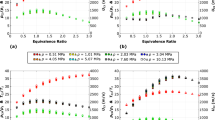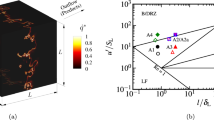Abstract
The resonance of thermal lags of solid fuel with heat transfer oscillations in a boundary layer flow is the primary cause of low-frequency instability initiation in hybrid rocket combustion. A detailed study of two cases was conducted experimentally to investigate how the boundary layer is disturbed and leads to low-frequency instability (LFI); combustion with swirl injection and combustion with the frequency jump. The fluctuating boundary layer was successfully captured by visualizing images and proper orthogonal decomposition analysis was performed. The results show that swirl injection with an appropriate intensity substantially reduces the amplitudes of high frequency p’, and no boundary layer perturbation is found in the spectral analysis of mode 2, and Rayleigh index amplifications disappear. While the frequency jump occurs, the coupling status between p’ and q’ became weakly positive and the driving force disturbing the upstream flow was not made. As a result, oscillatory heat transfer was difficult to occur. Therefore, the appearance of boundary layer perturbation is the necessary precondition for the initiation of the low-frequency instability. And the resonance with the thermal lag characteristic leads to the occurrence of LFI.
Similar content being viewed by others
Abbreviations
- FFT:
-
Fast Fourier transform
- LFI:
-
Low frequency instability
- POD:
-
Proper orthogonal decomposition
- RI:
-
Rayleigh index
- p’ :
-
Pressure oscillation in the 500 Hz band [-]
- q’ :
-
Heat release oscillation in the 500 Hz band [-]
References
A. Karabeyoglu, D. Zilwa and G. Zilliac, Modeling of hybrid rocket low frequency instabilities, Journal of Propulsion and Power, 21 (2005) 1107–1116.
K. S. Park and C. Lee, Low frequency instability in laboratory-scale hybrid rocket motors, Aerospace Science and Technology, 42 (2015) 148–157.
D. Kim and C. Lee, Destabilization of the shear layer in the post-chamber of a hybrid rocket, Journal of Mechanical Science and Technology, 30 (2016) 1671–1679.
C. Park and C. Lee, Vortices generation in the reactive flow on the evaporative surface, Journal of Mechanical Science and Technology, 29(2) (2015) 563–570.
H. Chae, D. Lee and C. Lee, Pressure and luminosity oscillation in post chamber of hybrid rocket, 54th AIAA/SAE/ASME/ ASEE Joint Propulsion Conference (2018).
J. Kim and C. Lee, Transition of combustion instability in hybrid rocket by swirl injection, Acta Astronautica, 158 (2018) 323–333.
J. D. Sterling and E. E. Zukoski, Nonlinear dynamics of laboratory combustor pressure oscillations, Combustion Science and Technology, 77 (1991) 225–238.
E. F. Charles and B. Y. Ernest, Effect of Large-Amplitude Oscillations on Heat Transfer, NASA TR R-142 (1962).
K. Obata, T. Shimada and K. Kitagawa, Imaging analysis of boundary layer combustion with tangential and radial oxidizer injection in a cylinder, 7th European Conference for Aeronautics and Space Sciences, Milan, Italy (2017).
J. Messineo, J. Lestrade, J. Hijlkema and J. Anthoine, 3D miles simulation of a hybrid rocket with swirl injection, Space Propulsion 2016 (2016).
W. Dunn and S. Tavoularis, Vortex shedding from a step-cylinder in shear flow, 6th International Symposium on Turbulence and Shear Flow Phenomena, Seoul, Korea (2009).
A. Schachenmann and D. Rockwell, Self-sustained oscillations of turbulent pipe flow terminated by an axisymmetric cavity, Journal of Sound and Vibration, 73 (1980) 61–72.
G. E. Choi and C. Lee, The change in flow dynamics inside the post-chamber of hybrid rocket, Journal of Mechanical Science and Technology, 29 (2015) 4711–4718.
J. E. Rossiter, Wind-Tunnel Experiments on the Flow Over Rectangular Cavities at Subsonic and Transonic Speeds, Royal Aircraft Establishment, Technical Report, 64037 (1964).
J. Messineo, Modeling hydrodynamic instabilities in hybrid rocket engines, Ph. D. Thesis, Federal University Toulouse Midi-Pyrénées (2016).
Y. Wang, L. Tan, B. Wang, S. Cao and B. Zhu, Numerical investigation on frequency jump of flow over a cavity using large eddy simulation, Journal of Fluids Engineering, 137 (2015) 1–10.
Acknowledgments
This work was supported by the research fund of the National Research Foundation (2018R1D1A1B07048676). In addition, the third author was supported by the research program of Konkuk University for his sabbatical leave in 2018.
Author information
Authors and Affiliations
Corresponding author
Additional information
Changjin Lee received Ph.D. from University of Illinois at Urbana-Champaign in 1992. He is currently a Professor in the Department of Aerospace Engineering at Konkuk University, Korea. His research interests include rocket and jet propulsions.
Jina Kim received B.S. in Aerospace Engineering from Konkuk University in 2019. She is a graduate student seeking for the master’s degree. Her research interests include rocket combustion and propulsion.
Rights and permissions
About this article
Cite this article
Kim, J., Lee, C. Low frequency instability and oscillating boundary layer in hybrid rocket combustion. J Mech Sci Technol 34, 4831–4839 (2020). https://doi.org/10.1007/s12206-020-1039-x
Received:
Revised:
Accepted:
Published:
Issue Date:
DOI: https://doi.org/10.1007/s12206-020-1039-x




